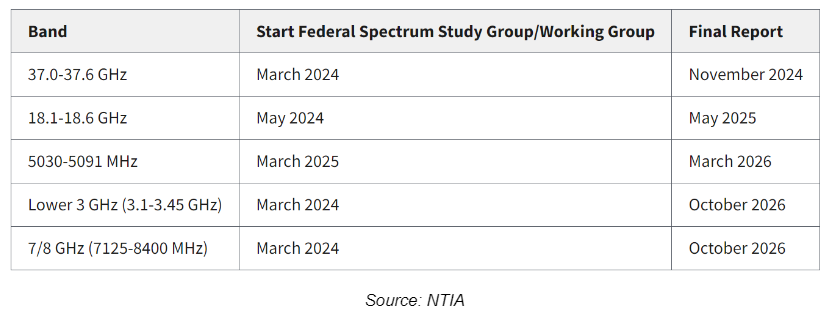NTIA released the plan for implementing the National Spectrum Strategy Tuesday. It comes after three GOP senators this week introduced a bill to restore the FCC’s spectrum auction authority and expand commercial access to mid-band spectrum.
The White House released the National Spectrum Strategy last November, Inside Towers reported. The National Spectrum Strategy identified a pipeline of spectrum bands to study for potential repurposing, and called for an improved framework for collaboration on spectrum policy.
The implementation plan is a public roadmap, detailing the timeline, milestones and responsible agencies for in-depth study of the 2,786 MHz of spectrum identified in the Strategy to determine suitability for potential sharing and/or new uses. That includes studying the potential for repacking, compression and relocation of airborne radars and other federal systems in the lower 3 GHz to allow for commercial use.
The Administration says building a spectrum pipeline is vital to meet the growing demand for airwaves to carry out public and private sector work. “The U.S. is in the midst of an intense competition for global leadership in the wireless space,” said NTIA Administrator Alan Davidson. “The Implementation Plan offers a roadmap to realize the vision of the National Spectrum Strategy and meet the global challenge before us.”
The National Spectrum Strategy also urged improved spectrum access and called for the development of a national spectrum workforce plan.
The implementation plan calls for using the Department of Commerce’s Spectrum Management Advisory Committee to build a new cooperative process for forming spectrum policy, with implementation of a national long-term spectrum planning process expected by September 2026.
Infrastructure trade groups embraced the implementation plan. WIA President/CEO Patrick Halley called it “an important step towards developing the predictable spectrum pipeline the U.S. needs to keep up with growing demand for wireless services and enable connectivity everywhere.” He said the plan provides a vital roadmap on the path forward, “but the hardest work is yet to come. It’s critical that NTIA continues its important leadership role and moves quickly to free up more spectrum for commercial use.”
“NATE is encouraged that both the White House and Congress are moving forward on a holistic spectrum strategy,” said association President/CEO Todd Schlekeway. “NATE members stand ready to engage policymakers, sharing the perspective of the communications infrastructure contractors and workers on the front lines of spectrum deployment.”
CTIA too, is “encouraged” by the plan, “which comes at a crucial time as America continues to trail other countries in freeing up mid-band spectrum for 5G networks,” said CTIA President/CEO Meredith Attwell Baker. “We are pleased to see the Administration restore NTIA leadership over spectrum studies, right the course on the lower 3 GHz band, and set up a critical review of the 7/8 GHz band.” Baker, too, echoed other associations and urged speed “to start these studies as we need decisive action on reallocating spectrum to secure our global economic competitiveness and innovation leadership.”
Public Knowledge is a non-profit that promotes open internet and access to affordable communications. Public Knowledge SVP Harold Feld called the plan “designed for real, not for show.”
“Rather than simply list aspirational goals to satisfy the wireless industry’s insatiable demand for spectrum, this implementation plan provides a pathway to a sustainable spectrum future that will maintain America’s leadership and bring the benefits of the wireless economy to all,” he stated.
Public Knowledge praised the Administration “for its commitment to expanding and diversifying the spectrum workforce. Lack of engineers, tower climbers, and other specialized workers needed to build out wireless networks delays deployment of next-generation networks and threatens our ability to continue to lead the world in wireless technologies,” he explained. “This is the first administration to propose a federal strategy to address this growing problem, and we are pleased at the commitment to doing so in a way that expands opportunities for those traditionally excluded from these well-paying jobs,” Feld added.
In contrast to the Administration’s plan, the GOP-backed Spectrum Pipeline Act of 2024, if passed, would require the NTIA to identify at least 2,500 MHz of mid-band spectrum that can be reallocated from federal use to non-federal or shared use in the next five years (including at least 1,250 MHz in the next two years). The FCC would be required to auction at least 600 MHz within three years and an additional 650 MHz in six years for full-power commercial wireless services, including 5G, Inside Towers reported.
FCC Commissioner Nathan Simington called the bill “a commonsense approach to quickly identify and allocate spectrum for commercial use.” He said it “recognizes and addresses the fact that the U.S. faces a shortage of licensed mid-band spectrum. The range of bands identified in this bill and the emphasis on licensed spectrum is crucial to allowing the U.S. to keep its competitive edge against China as the world’s technology leader.”
By Leslie Stimson, Inside Towers Washington Bureau Chief





Reader Interactions